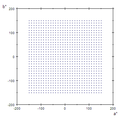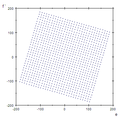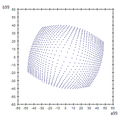DIN99 color space
|
|
DIN 6176 |
|---|---|
| Area | Colorimetry |
| title | Colorimetric determination of color differences in body colors according to the DIN99 formula |
| Brief description: | Color space system |
| Latest edition | 3.2001 |
| ISO |
The DIN99 color space system is a further development of the CIELAB color space system developed by the FNF / FNL 2 Colorimetry Working Committee . The calculation is described in DIN 6176: 2001-03 Colorimetric determination of color distances for body colors according to the DIN99 formula . This color space is also cited in the ASTM (American Society for Testing and Materials) ASTM D 2244 from 2007 Standard Practice for Calculation of Color Tolerances and Color Differences from Instrumentally Measured Color Coordinates .
Problem of equality
The reason for this development were deficiencies in the calculation of the perceptual equidistance of color distances in the CIELAB color space . The undervaluation of color distances close to the achromatic axis and weaknesses in the evaluation of highly saturated colors (high chroma values, especially the yellow tones) are further inadequacies of the CIELAB color space. The third point that has been corrected is the fact that CIELAB evaluates the brightness values (L *) insufficiently. To remedy these shortcomings, the CIE developed the color difference formulas CIE94 and CIEDE2000.
In contrast to the CIE94 and CIEDE2000 systems, the color distance formulas themselves are not modified in DIN99, but the entire color space is transformed to better equidistant. The result is a color space whose shape comes very close to the ideal of a sphere (complete equidistance) compared to CIELAB. The display of device color spaces looks unusual due to the typical (transformation-related) curvature, but allows a more true-to-life impression of the color space size and shape. The DIN99 color space itself is Euclidean (right-angled). The curvature of the color space display is created solely by the transformed CIELAB coordinates. Therefore the calculation of the color difference remains unchanged. It is determined by the Euclidean distance , as in CIELAB.
description
The basis of the DIN99 color space is the CIELAB color space with its coordinates .
The transformation from CIELAB to DIN99 is carried out in two parts: A brightness transformation to the new DIN99 brightness and a chroma transformation.
After the transformations, the values such as chroma ( ), hue angle ( ) and color distance ( ) can then be calculated.
Application requirements
The DIN99 formula is designed for small to medium color differences. The application is recommended for color distances up to 5 CIELAB.
Viewing conditions
The reference conditions for the evaluation are as follows (according to CIE publications 101 and 116):
- Illuminant D65
- 1000 lx
- Ambient color 50 L * (CIELAB)
- Sample size should encompass more than 4 ° of the field of view (corresponding to 10 ° standard observer)
- Sample and comparison sample as homogeneous as possible (without structure)
- Sample and comparison sample directly adjacent to one another.
- Brightness of the pattern in the range of 50 L * (CIELAB)
- Observer: color normal sighted
- Appearance: body color
- Size of the color difference: less than 5 CIELAB units
| L * | a * | b * | L 99 | a 99 | b 99 | c 99 | h 99 |
|---|---|---|---|---|---|---|---|
| 50% | +10 | +10 | 61.43% | +9.70 | +3.76 | + 10.40 | 21.21 ° |
| +50 | +50 | +28.64 | +11.11 | +30.72 | |||
| −10 | +10 | −5.57 | +7.03 | +8.97 | 128.37 ° | ||
| −50 | +50 | −17.22 | +21.75 | +27.74 | |||
| −10 | −10 | −9.70 | −3.76 | + 10.40 | 201.21 ° | ||
| −50 | −50 | −28.64 | −11.11 | +30.72 | |||
| +50 | −10 | +5.57 | −7.03 | +8.97 | 308.37 ° | ||
| +50 | −50 | +17.22 | -21.75 | +27.74 | |||
| 0% | 0 | 0 | 0% | 0 | 0 | 0 | - |
| 100% | 100% |
calculation
Brightness transformation
The brightness is transformed to DIN99 brightness :
This transformation is intended to better reflect the distinguishability of dark hues. The transformation is similar to a power function with an exponent of 0.75. The area of dark tones is stretched and the area of light tones is compressed. Average brightness values are shifted up on the brightness axis.
The variable describes the influence of changed viewing conditions, which applies under reference conditions .
Chroma transformation
The transformation of the chroma coordinates takes place in three steps:
- The chroma axes are rotated by 16 °
- The yellow-blue axis is multiplied by a factor of 0.7, i.e. compressed
- The chroma values are compressed logarithmically radially around the axis
In contrast to the CIE94 and CIEDE2000 formulas, it is not necessary to determine the hue angle to calculate the color distance.
Intermediate calculations
First the intermediate calculations that are necessary to determine the color difference:
and are transformed to
- Redness values (red-green axis)
- Yellowness value f (yellow-blue axis)
The chroma value G (chroma) is then calculated from this:
With
Hue values
If the case arises that , well , then holds
Color distance formula
The color difference can then simply be determined using the following formula :
Further calculations
A preliminary hue angle can also be determined for the calculation:
- , Angles in radians
Chroma and hue angle (Hue)
The chroma is calculated as follows:
- , with the variable parameters and , standard values
Note: and depend on the respective viewing conditions, analogous to the values l and c in the CMC (l: c) color distance formula. Other sources (not DIN) indicate for and for . The DIN advises against changing the factors and recommends the default value of 1 for both. The result remains the same due to the multiplication.
The hue angle results from :
- , Angle in degrees
Hue values (alternative)
From and the hue values can also be calculated:
Chroma difference
- , M = sample color, V = comparison color
Difference in hue angle
- , M = sample color, V = comparison color
Color difference (alternative calculation)
The color difference can also be calculated from the chroma and the hue angle:
Inverse calculations
The following formulas are used to determine the corresponding values in the CIELAB color space:
Intermediate value for DIN99 hue angles
For all calculations in this section, the angle in radians applies.
- For and ≥ 0
- , for and
- , For
- , for and
- , for and ≤ 0
- , for and
Intermediate value for DIN99 chroma
Intermediate value for DIN99 redness
Intermediate value for DIN99 yellowness
CIELAB redness and yellowness axes
CIELAB brightness
With existing values of h 99 and C 99
If the DIN99 chroma value and hue angle are already given, then calculate first
- , Angles in radians
and continue with the calculation from the intermediate value G for DIN99 chroma.
Quality and further development
The DIN99 color space approximates the CIE94 color distance formula very well and has similar qualitative properties, also comparable to CMC (l: c). A major advantage over CIE94 is the interchangeability of sample and comparison samples in the calculation, which is made possible by the fact that the transformation is completely and easily reversible. The difference to CIELAB lies in the improved correspondence of the calculations with perceived color differences. The modification of the lightness axis and the stronger weighting of the colors near the achromatic axis through the compression of strongly saturated colors considerably increase the equality of perceived color differences. The evaluation categories for lightness and hue axes (yellow-blue and red-green) do not change compared to CIELAB. The calculation of the color distance as a simple Euclidean distance is a big advantage compared to CMC (l: c), CIE94 and CIEDE2000, the calculation of which is much more complicated. Subsequent improvements to the DIN99 color space (DIN 6176: 2001-03) produce a quality similar to that achieved with CIE94 and CIEDE2000.
Even after the further development of the DIN99 color space, a problem remains. Tolerance ellipses are still shown as ellipses and not as circles in the blue area of the DIN99 color space. Cui, Lou, et al. modified the DIN99 formulas in 2001 to solve this problem. This resulted in three color space variants: DIN99b, DIN99c and DIN99d. Several color tolerance data sets (VFD-P, RIT-DuPont, Leeds and Witt), which were merged into one overall data set, served as the basis for optimizing the DIN99 formula and for assessing color tolerances (the tolerance ellipses according to MacAdams). In terms of quality, the assessment of color tolerances in the blue region of the DIN99b color space was poorer than with the CIEDE2000 formula. Color tolerances were still mapped as ellipses in the blue region. To solve the problem, the a * and b * values of the CIELAB color space were linearized and a blue correction was carried out in the CIELAB color space. For the blue correction, the X value of a color used from the XYZ color space was additionally weighted with a proportion of the Z value. Only after this weighting does the CIELAB calculation take place, which is the basis for the DIN99 color space. This correction flows into both the DIN99c and DIN99d color spaces. In contrast to DIN99, DIN99c is not rotated, i.e. oriented in the same way as the CIELAB color space. However, DIN99d is rotated by 50 ° compared to CIELAB. In tests with the new color data set, all three variants represent an improvement, but only DIN99c and DIN99d offer significant improvements over DIN99 in the blue region. Color tolerance ellipses are also shown almost circularly in the blue area in both DIN99c and DIN99d. This further development enables a quality comparable to that of CIEDE2000 for the determination of color tolerances and distances, with less computational effort.
Individual evidence
- ↑ Dipl.-Ing. H. Büring: Properties of the color space according to DIN 6176 (DIN99 formula) and its importance for industrial use . (Link no longer exists) February 2, 2008.
- ↑ Dr. L. Gall - Colorimetry for pigment processors - DIN99 archive link ( Memento from February 21, 2008 in the Internet Archive ) February 2, 2008, archive checked on January 23, 2020
- ↑ DIN 6174, colorimetric determination of color differences in body colors according to the CIELAB formula
- ↑ DIN 6176: 2001-03, colorimetric determination of color differences in body colors according to the DIN-99 formula
- ↑ German Color Science Society: Press release on DIN 99 (DIN 6176) color space http://www.dfwg.de/doc/dfwg-homepage-417.htm February 2, 2008
- ↑ MR Luo, B. Rigg, Chromaticity-discrimination ellipses for surface colors , Color Research and Application, 11: 25-42, 1986
- ^ DH Kim, JH Nobbs, New weighting functions for the weighted CIELAB color-difference formula , Proc Color 97 Kyoto, 1: 446-449, 1997
- ↑ K. Witt, Geometric relations between scales of small color-differences , Color Research and Application, 24: 78-92, 1999



































































